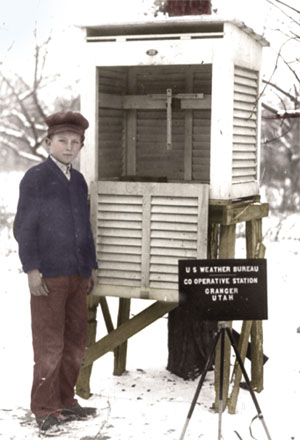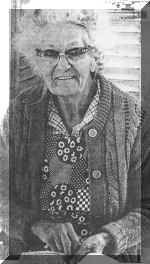In 1644
and 1655, John Campanius Holm, a Lutheran minister, was the first
observer to take systematic observations in the American Colonies.
 In
1776, Thomas Jefferson began to recruit volunteer weather observers
throughout Virginia. By 1800, there were volunteers in five other
states across the newborn nation. They included Massachusetts, Pennsylvania,
Connecticut, New York and North Carolina. In 1891, the network of
voluntary weather observers across the country had grown to 2,000
stations.
In
1776, Thomas Jefferson began to recruit volunteer weather observers
throughout Virginia. By 1800, there were volunteers in five other
states across the newborn nation. They included Massachusetts, Pennsylvania,
Connecticut, New York and North Carolina. In 1891, the network of
voluntary weather observers across the country had grown to 2,000
stations.
In 1890,
the growing volunteer force was taken over by the Smithsonian Institution.
It was not until 1953 that a plan was established to evenly blanket
the nation with weather observers. Dr. Helmut Landsberg of the Weather
Bureau conducted a study with Iowa State University to establish a
method of filling in the open spaces of this volunteer network. As
a result of this study, it was determined that there should be one
weather station every 25 miles for estimating rainfall within an accuracy
tolerance of ten percent. By 1990, the network had expanded to 10,000
sites. The most recent statistics estimate that there are 12,000 cooperative
observers in the United States.
To date,
Mr. Edward G. Stoll, who took weather observations for 76 years in
Arapahoe, Nebraska, has the longest history as a Cooperative Weather
Observer. He had a 50 year award named after him. Recently, Mrs. Ruby
Stufft, a volunteer weather observer from Elsmere, Nebraska, received
the first ever Ruby Stufft Award. This award will be presented to
any observer who volunteers 70 years of their time. She recorded the
weather for 70 years and became the first woman to reach that landmark.
A
Valuable Service
In 1933, the Secretary of Agriculture, Henry Wallace, with a science
advisory group, told President Roosevelt that the Cooperative Program
is one of the most extraordinary services ever developed, netting
the public more per dollar expended than any other government service
in the world. That statement is still valid today. It is estimated
that their time totals over a million hours a year. Only about a third
of them are paid, and the ones that do get paid receive a very small
amount.
Climatological
records get more valuable with time. The climatological base generated
through the efforts of the volunteer Cooperative Weather Observer
provides not only the cornerstone of our nation's weather history,
but also serves as the primary data for research into global climatic
change.
On a
local level, the observations received by volunteer observers are
fundamental in helping the NWS to protect life and property. Forecasts
are often based on observer data, and even warnings for severe weather
have been issued based on information received from a volunteer. Once
a month, the local weather office collects all the data and sends
it to the National Climatic Data Center in Asheville, NC. There it
is entered into a huge national database that is accessible by the
public. A majority of requests for this data come from Attorneys,
Insurance Companies, Meteorological Consultants, Businesses (including
construction), Utilities, Universities, Transportation, Agriculture,
Education and the Media.
Individual Awards
Two of
the more prestigious awards are the Thomas Jefferson award and the
John Campanius Holm award. Both were created in 1959 for the National
Weather Service to honor cooperative weather observers, and the first
of each was presented in 1960. To be eligible for these awards, observers'
excellence must include accuracy, promptness, legibility, cooperation,
consistency and care of equipment. These things must have been done
over a long period of time.
Thomas
Jefferson - This award is to honor cooperative weather observers
for unusual and outstanding achievements in the field of meteorological
observations. It is the highest award the NWS presents to volunteer
observers. The award is named for Thomas Jefferson, third president
of the US. Jefferson made an almost unbroken series of weather observations
from 1776 to 1816. No more than 5 Jefferson awards are given annually.
This certificate is signed by the Secretary of Commerce and the Under
Secretary for Oceans and Atmosphere. To be eligible for the Jefferson
award, a candidate must have received the Holm award at least five
years prior, and must still be performing her or his duties in an
outstanding manner.
John
Campanius Holm - This award is to honor cooperative observers
for outstanding accomplishments in the field of meteorological observations.
It is named for a Lutheran minister, the first person known to have
taken systematic weather observations in the American Colonies. Reverend
Holm made observations of climate without the use of instruments in
1644 and 1645, near the present site of Wilmington, Delaware. No more
than twenty-five Holm awards are given annually. The certificate is
signed by the Administrator of the National Oceanic and Atmospheric
Administration (NOAA).

Mrs. Ruby Stufft |
Earl
Stewart - This award was named for an observer in Cottage
Grove, Oregon. Mr. Stewart completed 75 years of continuous observations
in 1992. The criterion
for this
award is that an observer serve the NWS as an observer for a period
of 75 years or more.
Ruby
Stufft - In 1991, Mrs.
Ruby Stufft of Elsmere, Nebraska, completed 70 years
as a cooperative observer. This award was named in her honor, and
is presented to any observer attaining 70 years of service.
Albert
J. Meyer - The award was named after an observer at Eagle
Pass, Texas. In 1870 Mr. Meyer was appointed to establish and direct
the "Division of Telegrams and Reports for the Benefit of Commerce,"
now known as the NWS. Anyone who serves as an observer for 65 years
is eligible for this award.
Helmut
E. Landsberg - This award was created in 1986 in honor of
Dr. Helmut E. Landsberg, one of the preeminent climatologists of our
time. This award is presented to all observer who have completed 60
years of service as cooperative observers.
Edward
H. Stoll - This award was created and became effective in
1975 in honor of Mr. Edward H. Stoll. Mr. Stoll was the observer at
Elwood, Nebraska for over 76 years and was the first to receive the
prestigious Stoll award. To receive this award, an observer must have
taken observations for 50 years. The Stoll, Landsberg, Myer, Stufft,
and Stewart awards are all signed by the Assistant Administrator of
Weather Services (Director of the NWS)
Length
of Service awards, emblems and letters Cooperative observers
may be given length-of-service emblems every five years, starting
at ten years of service to 50 years of service. There are also length
of service certificates that may be issued every 5 years through 50
years. The 10 and 15 year certificates are bronze, the 20 and 25 year
are silver, and the 30 through 50 year are gold. 60-year observers
and higher will receive a letter signed by the President of the United
States.
Institutional
Awards
Institutions
include schools, power stations, Corps of Engineer dams, local governments,
and other entities, where an individual is not identified as the observer.
Often, whomever is working at observation time will record the data.
Institutions shall receive an award for each 25 years of service.
The certificate is signed by the Assistant Administrator for Weather
Services and the local official.
Special
Service awards -These are presented from a local level, and
may be given for any reason that is appropriate. This may include
recognition for an individual who has been the primary observer for
many years at an institution, and otherwise would not be officially
recognized.



